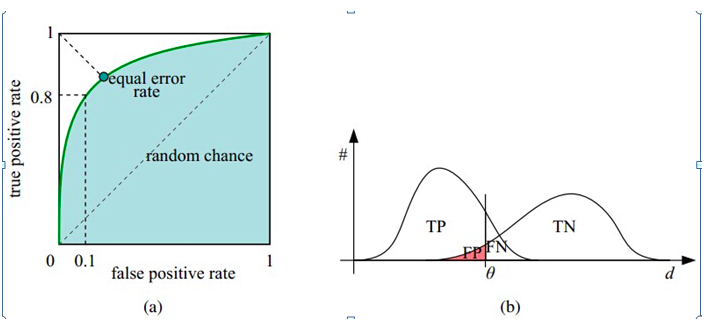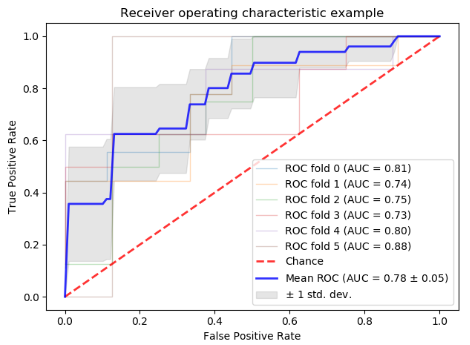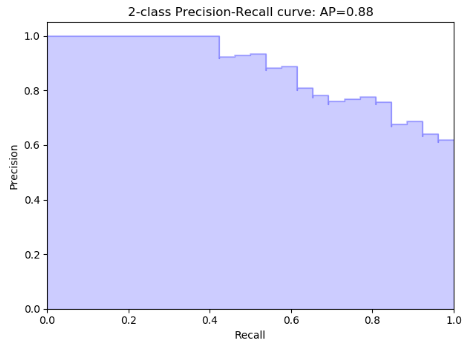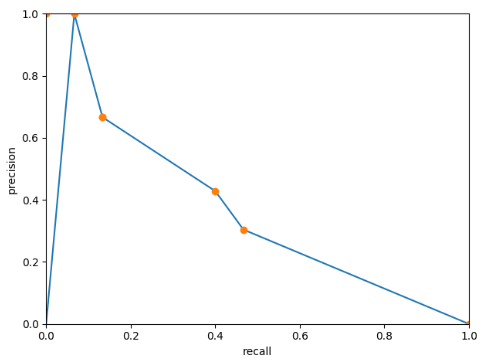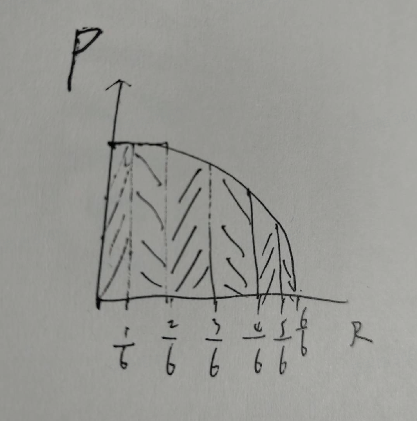Receiver Operating Characteristic (ROC) with cross validation — scikit-learn 1.0.2 documentation
Precision-Recall — scikit-learn 1.0.2 documentation
一,ROC
横轴:负正类率(false postive rate FPR)特异度,划分实例中所有负例占所有负例的比例;(1-Specificity)
负正类率(False Postive Rate)FPR: FP/(FP+TN),代表分类器预测的正类中实际负实例占所有负实例的比例。1-Specificity
纵轴:真正类率(true postive rate TPR)灵敏度,Sensitivity(正类覆盖率)
真正类率(True Postive Rate)TPR: TP/(TP+FN),代表分类器预测的正类中实际正实例占所有正实例的比例。
如下面这幅图,(a)图中实线为ROC曲线,线上每个点对应一个阈值。
横轴FPR:1-TNR,1-Specificity,FPR越大,预测正类中实际负类越多。
纵轴TPR:Sensitivity(正类覆盖率),TPR越大,预测正类中实际正类越多。
理想目标:TPR=1,FPR=0,即图中(0,1)点,故ROC曲线越靠拢(0,1)点,越偏离45度对角线越好,Sensitivity、Specificity越大效果越好。
假设已经得出一系列样本被划分为正类的概率,然后按照大小排序,下图是一个示例,图中共有20个测试样本,“Class”一栏表示每个测试样本真正的标签(p表示正样本,n表示负样本),“Score”表示每个测试样本属于正样本的概率。
接下来,我们从高到低,依次将“Score”值作为阈值threshold,当测试样本属于正样本的概率大于或等于这个threshold时,我们认为它为正样本,否则为负样本。举例来说,对于图中的第4个样本,其“Score”值为0.6,那么样本1,2,3,4都被认为是正样本,因为它们的“Score”值都大于等于0.6,而其他样本则都认为是负样本。每次选取一个不同的threshold,我们就可以得到一组FPR和TPR,即ROC曲线上的一点。这样一来,我们一共得到了20组FPR和TPR的值,将它们画在ROC曲线的结果如下图:

AUC(Area under Curve):Roc曲线下的面积,介于0.1和1之间。Auc作为数值可以直观的评价分类器的好坏,值越大越好。
首先AUC值是一个概率值,当你随机挑选一个正样本以及负样本,当前的分类算法根据计算得到的Score值将这个正样本排在负样本前面的概率就是AUC值,AUC值越大,当前分类算法越有可能将正样本排在负样本前面,从而能够更好地分类。
为什么使用Roc和Auc评价分类器
既然已经这么多标准,为什么还要使用ROC和AUC呢?因为ROC曲线有个很好的特性:当测试集中的正负样本的分布变换的时候,ROC曲线能够保持不变。在实际的数据集中经常会出现样本类不平衡,即正负样本比例差距较大,而且测试数据中的正负样本也可能随着时间变化。下图是ROC曲线和Presision-Recall曲线的对比:
在上图中,(a)和(c)为Roc曲线,(b)和(d)为Precision-Recall曲线。
(a)和(b)展示的是分类其在原始测试集(正负样本分布平衡)的结果,(c)(d)是将测试集中负样本的数量增加到原来的10倍后,分类器的结果,可以明显的看出,ROC曲线基本保持原貌,而Precision-Recall曲线变化较大。
import numpy as np
from scipy import interp
import matplotlib.pyplot as plt
from sklearn import svm, datasets
from sklearn.metrics import roc_curve, auc
from sklearn.model_selection import StratifiedKFold
# #############################################################################
# Data IO and generation
# Import some data to play with
iris = datasets.load_iris()
X = iris.data
y = iris.target
X, y = X[y != 2], y[y != 2]
print('X.shape=',X.shape)
print('y.shape=',y.shape)
print(y)
n_samples, n_features = X.shape
# Add noisy features
random_state = np.random.RandomState(0)
X = np.hstack([X, random_state.randn(n_samples, 200 * n_features)])
print('X.shape=',X.shape)
# #############################################################################
# Classification and ROC analysis
# Run classifier with cross-validation and plot ROC curves
cv = StratifiedKFold(n_splits=6)
classifier = svm.SVC(kernel='linear', probability=True,
random_state=random_state)
tprs = []
aucs = []
mean_fpr = np.linspace(0, 1, 100)
i = 0
for train, test in cv.split(X, y):
probas_ = classifier.fit(X[train], y[train]).predict_proba(X[test])
print(probas_)
print('probas_.shape=',probas_.shape)
# Compute ROC curve and area the curve
fpr, tpr, thresholds = roc_curve(y[test], probas_[:, 1])
tprs.append(interp(mean_fpr, fpr, tpr))
tprs[-1][0] = 0.0
roc_auc = auc(fpr, tpr)
aucs.append(roc_auc)
plt.plot(fpr, tpr, lw=1, alpha=0.3,
label='ROC fold %d (AUC = %0.2f)' % (i, roc_auc))
i += 1
plt.plot([0, 1], [0, 1], linestyle='--', lw=2, color='r',
label='Chance', alpha=.8)
mean_tpr = np.mean(tprs, axis=0)
mean_tpr[-1] = 1.0
mean_auc = auc(mean_fpr, mean_tpr)
std_auc = np.std(aucs)
plt.plot(mean_fpr, mean_tpr, color='b',
label=r'Mean ROC (AUC = %0.2f $\pm$ %0.2f)' % (mean_auc, std_auc),
lw=2, alpha=.8)
std_tpr = np.std(tprs, axis=0)
tprs_upper = np.minimum(mean_tpr + std_tpr, 1)
tprs_lower = np.maximum(mean_tpr - std_tpr, 0)
plt.fill_between(mean_fpr, tprs_lower, tprs_upper, color='grey', alpha=.2,
label=r'$\pm$ 1 std. dev.')
plt.xlim([-0.05, 1.05])
plt.ylim([-0.05, 1.05])
plt.xlabel('False Positive Rate')
plt.ylabel('True Positive Rate')
plt.title('Receiver operating characteristic example')
plt.legend(loc="lower right")
plt.show()ROC缺点:假如增加大量的N样本,由于整体不变,故FP也会增加,对于信息检索等关注正例的准确性有很大影响。
二,AP
1.PR曲线的横轴Recall也就是TPR,反映了分类器对正例的覆盖能力。而纵轴Precision的分母是识别为正例的数目,而不是实际正例数目。Precision反映了分类器预测正例的准确程度。那么,Precision-recall曲线反映了分类器对正例的识别准确程度和对正例的覆盖能力之间的权衡。AP就是PR曲线与X轴围成的图形面积。
from sklearn import svm, datasets
from sklearn.model_selection import train_test_split
import numpy as np
iris = datasets.load_iris()
X = iris.data
y = iris.target
# Add noisy features
random_state = np.random.RandomState(0)
n_samples, n_features = X.shape
X = np.hstack([X, random_state.randn(n_samples, 200 * n_features)])
# Limit to the two first classes, and split into training and test
X_train, X_test, y_train, y_test = train_test_split(X[y < 2], y[y < 2],
test_size=.5,
random_state=random_state)
# Create a simple classifier
classifier = svm.LinearSVC(random_state=random_state)
classifier.fit(X_train, y_train)
y_score = classifier.decision_function(X_test)
from sklearn.metrics import average_precision_score
average_precision = average_precision_score(y_test, y_score)
print('Average precision-recall score: {0:0.2f}'.format(
average_precision))
from sklearn.metrics import precision_recall_curve
import matplotlib.pyplot as plt
from sklearn.utils.fixes import signature
precision, recall, _ = precision_recall_curve(y_test, y_score)
# In matplotlib < 1.5, plt.fill_between does not have a 'step' argument
step_kwargs = ({'step': 'post'}
if 'step' in signature(plt.fill_between).parameters
else {})
plt.step(recall, precision, color='b', alpha=0.2,
where='post')
plt.fill_between(recall, precision, alpha=0.2, color='b', **step_kwargs)
plt.xlabel('Recall')
plt.ylabel('Precision')
plt.ylim([0.0, 1.05])
plt.xlim([0.0, 1.0])
plt.title('2-class Precision-Recall curve: AP={0:0.2f}'.format(
average_precision))
plt.show()2.计算ap
利用插值法,计算AP也就是pr曲线的面积,代码如下
import numpy as np
import matplotlib.pyplot as plt
def voc_ap(rec, prec):
# correct AP calculation
# first append sentinel values at the end
mrec = np.concatenate(([0.], rec, [1.])) # [0. 0.0666 0.1333 0.1333 0.4 0.4666 1. ]
mpre = np.concatenate(([0.], prec, [0.])) # [0. 1. 0.6666 0.6666 0.4285 0.3043 0. ]
print('==mrec:', mrec)
print('==mpre:', mpre)
plt.ylim((0, 1))
plt.xlim((0, 1))
plt.xlabel('recall')
plt.ylabel('precision')
plt.plot(mrec, mpre)
# compute the precision envelope
# 计算出precision的各个断点(折线点)
for i in range(mpre.size - 1, 0, -1):
mpre[i - 1] = np.maximum(mpre[i - 1], mpre[i]) # [1. 1. 0.6666 0.6666 0.4285 0.3043 0. ]
print('precision的各个断点:', mpre)
plt.plot(mrec, mpre, 'o')
plt.show()
# to calculate area under PR curve, look for points
# where X axis (recall) changes value
i = np.where(mrec[1:] != mrec[:-1])[0] # precision前后两个值不一样的点
print(i) # [0, 1, 3, 4, 5]
print('===mpre[i]:', mpre[i])
print('===mpre[i+1]:', mpre[i+1])
print('===mrec[i + 1]=', mrec[i + 1])
print('===mrec[i]=', mrec[i])
# AP= AP1 + AP2 + AP3 + AP4
ap = np.sum((mrec[i + 1] - mrec[i]) * mpre[i+1])
return ap
prec = np.array([1., 0.6666, 0.6666, 0.4285, 0.3043])
rec = np.array([0.0666, 0.1333, 0.1333, 0.4, 0.4666])
# Precision = ['1.00', '0.50', '0.67', '0.50', '0.40', '0.33', '0.29', '0.25', '0.22', '0.30', '0.27', '0.33', '0.38', '0.43', '0.40', '0.38', '0.35', '0.33', '0.32', '0.30', '0.29', '0.27', '0.30', '0.29']
# Recall = ['0.07', '0.07', '0.13', '0.13', '0.13', '0.13', '0.13', '0.13', '0.13', '0.20', '0.20', '0.27', '0.33', '0.40', '0.40', '0.40', '0.40', '0.40', '0.40', '0.40', '0.40', '0.40', '0.47', '0.47']
#
# prec = np.array(list(map(float, Precision)))
# rec = np.array(list(map(float, Recall)))
ap = voc_ap(rec, prec)
print('==ap:', ap)要注意的是rec的终点是0.4666,不是补过的1
例子:计算某类别AP0.5:
IOU=0.5,就认为匹配上记为1,否则没匹配记为0:
第一副图:两个GT,三个预测框分别是(0.3, 1), (0.5, 0), (0.9, 1)
第二副图:0GT,一个预测框(0.45, 0)
第三副图:一个GT,无预测
第四副图:三个GT,5个预测框分别是(0.85,1), (0.8,1),(0.7,1),(0.35,0),(0.1, 0)
第五副图:无GT,无预测
也就是Ngt = 6,9组数据按score排序,
(0.9, 1),(0.85,1), (0.8,1),(0.7,1), (0.5, 0),(0.45, 0),(0.35,0),(0.3, 1), (0.1, 0)
依次去掉最后一组数据计算PR
P,R依次为(5/9, 5/6),(5/8, 5/6),(4/7,4/6),(4/6,4/6),(4/5,4/6),(4/4,4/6),(3/3,3/6),(2/2,2/6),(1/1,1/6)
9组。
如R相等时,取最大P,故AP=(5/8+4/4+3/3+2/2+1/1+0)/6=0.77
使用场景:1.ROC由于关注正例和负例,所以适合用于评估分类器的整体性能,相比而言PR曲线完全聚焦于正例。
2.若果有多份数据,且存在不同的类别分布,比如信用卡欺诈每个月的正负比例都会变,若果只是单纯比较分类器的性能不要类别分布改变的话就用ROC,反之想要测试不同类别的分布对分类器性能的影响,则用PR。
参考:
机器学习之分类器性能指标之ROC曲线、AUC值 – dzl_ML – 博客园
今天的文章ROC曲线,AUC值,PR曲线,AP值分享到此就结束了,感谢您的阅读。
版权声明:本文内容由互联网用户自发贡献,该文观点仅代表作者本人。本站仅提供信息存储空间服务,不拥有所有权,不承担相关法律责任。如发现本站有涉嫌侵权/违法违规的内容, 请发送邮件至 举报,一经查实,本站将立刻删除。
如需转载请保留出处:https://bianchenghao.cn/9160.html

